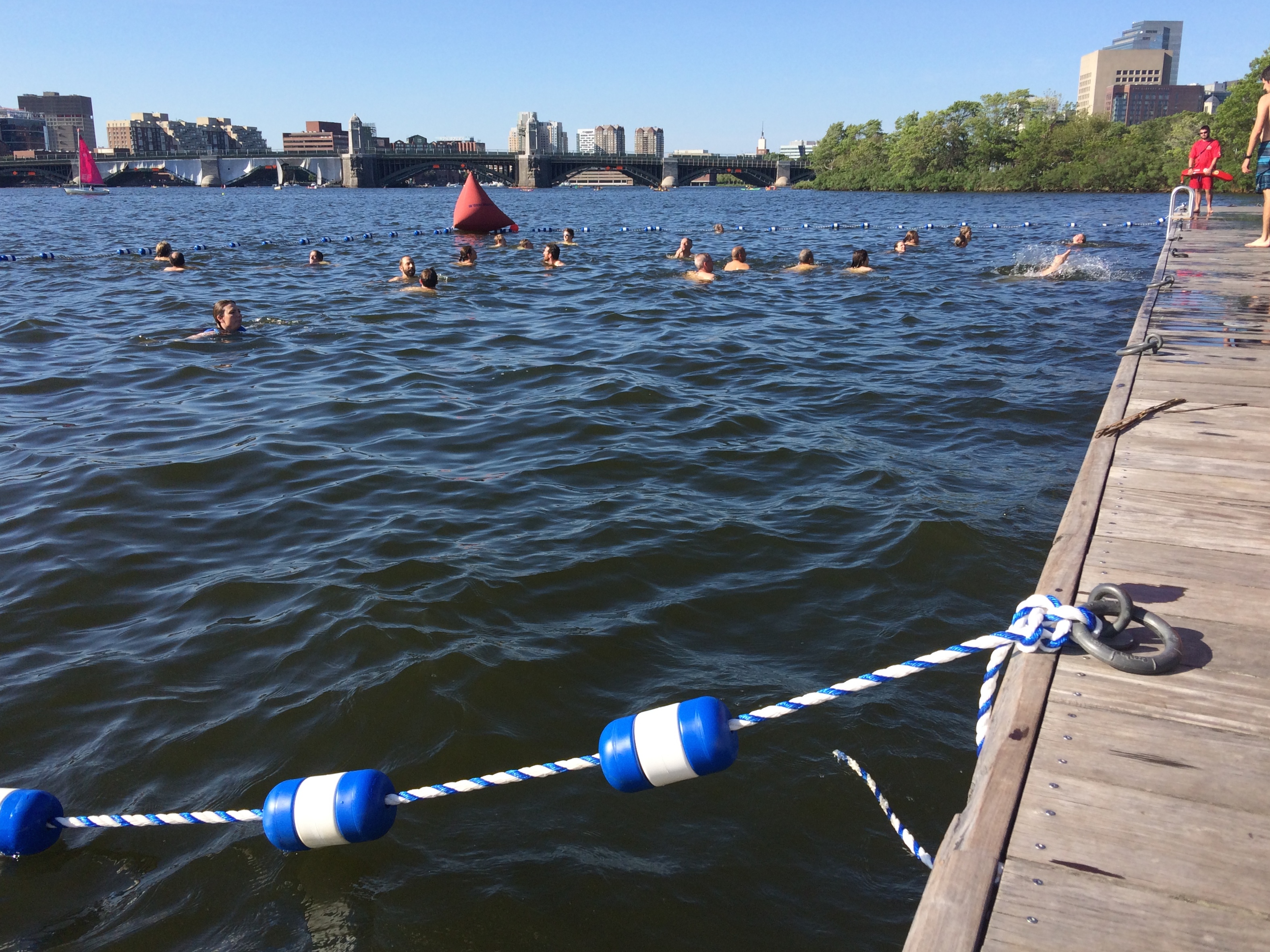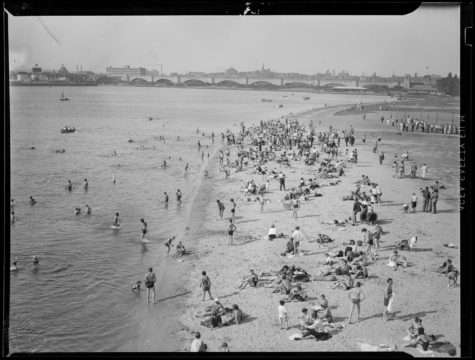 The hot, thick summer air in Cambridge, Massachusetts, can make you feel like you’re sitting in a sauna, wrapped in a soaking-wet wool blanket. As a recent, temporary transplant, staying in a house without air conditioning, I needed a place to cool off.
The hot, thick summer air in Cambridge, Massachusetts, can make you feel like you’re sitting in a sauna, wrapped in a soaking-wet wool blanket. As a recent, temporary transplant, staying in a house without air conditioning, I needed a place to cool off.
I’ve gotten to know all my favorite places by immersing myself in their water—the lakes and ponds that dot the Adirondacks, the rivers that cut through interior Alaska. For me, swimming outside is a joy, a relief, and a way to feel the pulse of the landscape.
My first week in Cambridge, I found a park called Magazine Beach at the end of my street, tucked into an elbow of the Charles River. For a day or two, I thought I’d discovered the perfect spot to escape the heat and get acquainted with my new town. But the name of the park is a relic, left over from decades ago. These days, the river is off-limits to swimmers.
Well, not completely off-limits. Sitting in my sweltering house, sweat dripping down my back, I scoured the internet for some explanation for the ban—or a loophole. I found both.
Seventy-five years ago, I could have spent the afternoon happily dunking under the waves at Magazine  Beach instead of slowly melting into my couch. Black-and-white photographs taken around 1940 show crowds of people relaxing on a wide, sandy beach at the river’s edge, lounging, wading, and cooling off in the water. Not long after that, though, the pollution pouring into the river became too obvious to ignore.
Beach instead of slowly melting into my couch. Black-and-white photographs taken around 1940 show crowds of people relaxing on a wide, sandy beach at the river’s edge, lounging, wading, and cooling off in the water. Not long after that, though, the pollution pouring into the river became too obvious to ignore.
Over the years, the Charles was treated like a latrine and a garbage can, just like hundreds of other rivers. Decades of manufacturing and industry within the river’s watershed have left its sediments laced with pollutants, and rain still flushes bacteria-laden water down its creeks and streams. The Charles River Watershed Association collects water samples from sites along the river, and last year, the E. coli levels in one-third of those samples exceeded state safe swimming standards.
Officials track E. coli because it’s a good indicator of other, more dangerous bugs that lurk in human sewage: pathogens that can cause vomiting and diarrhea, and even spread diseases like hepatitis. Would-be Charles River swimmers face the same question—albeit on a different scale—that Olympic boaters, triathletes, and marathon swimmers must answer in Rio this month. If bacteria levels are high on the day you want to be in the water, is the risk worth it?
And yet, thanks to sewer system upgrades and laws limiting industrial discharge, the Charles River is cleaner now than it’s been since the era of the historic beach photos. Clean enough, in fact, that city authorities allow a couple carefully orchestrated swimming events each year.
The organizers of those events have to take precautions, of course. City-sanctioned swims start from docks instead of beaches to avoid stirring up contaminated sand. And because the watershed association carefully tracks the concentration of E. coli in the river, coordinators can cancel a swim at the last minute if it rains somewhere upstream.
In my sweat-fueled search, I found one of those swims—a once-a-year event organized by a group that hopes to open a permanent city swimming spot on the river someday. Smiling at my computer screen, I signed right up.
Two days later, I sat on a wooden dock, a thick curtain of heat rising from the sun-warmed slats under my thighs. I plunked my feet into the Charles, and the sudden chill of the water sent a shiver through my body. The gentle buzz of sloshing waves and chatting friends drifted up from the buoy-lined square of river in front of me. Setting my sunglasses on the edge of the dock, I slid down, straight into the deep, cool water.
I bobbed back up, my hair dripping in my face. Across the river, the streets and buildings of Cambridge stretched toward the sky behind a row of trees. Treading, I turned around and looked back across the dock. As joggers and dog-walkers paused to stare in disbelief at the two dozen or so swimmers paddling around me, I could almost see their thoughts: “Isn’t that dirty water dangerous?” Standing in the sun, they looked hot.
Down at the river, two friends cannonballed off the dock in unison, laughing as they resurfaced. One woman in a white bathing cap and goggles gamely tried to swim laps across the far buoy-line, detouring to avoid other swimmers floating and playing and reveling in the slanting afternoon sunlight. We’d each signed a release before jumping in, but it felt pretty much like any other outdoor dip, each of us drawn there by the pull of the water.
When the lifeguards blew the final whistle, I lined up with the other swimmers, treading water and waiting my turn to climb up the ladder. Fifteen minutes later, the sign-in booth was a pile of poles and cloth on the ground, the buoy-lines were coiled up, and the Massachusetts state parks boat that had watched over us had roared off down the river. The dock was back to normal, and the joggers and dog-walkers had turned back to their paved path.
I stuck my wet feet into my sandals to walk home and considered driving out to Walden Pond later that week, or taking the ferry out to the cape to soak in the ocean. But what I really wanted was a place for a quick swim after work—a laid-back spot, a nearby neighborhood gathering place.
I walk by the Charles almost every day, and it’s so inviting, the kayak- and crew shell-dotted waves so tantalizing. There aren’t any more official swims in the river this summer. But maybe I’ll keep an eye on the bacteria levels, and follow a suggestion I found on an online message board: It’s not illegal to canoe in the river. Nor is it illegal, of course, to fall out of your canoe.
Emily Benson, a recent graduate of the UCSC Science Communication Program, is an intern at New Scientist magazine.
Top photo: Swimming in the Charles in 2016. Photo by the author.
Bottom photo: Swimming in the Charles around 1940. Photo courtesy of the Boston Public Library, Leslie Jones Collection.
Great story! I wonder if anyone got sick?
When I lived in Boston for a summer, I did the public boating (I forget what it’s called). One fee for the entire summer. They teach you how to sail one of the small boats – though I had already had lessons. Even if you don’t dunk in the water, it’s still much cooler out on the river than up on the shore.
charming!
Sending this to my sister-in-law, who frequents a few Arlington-area swimming holes.